Experimental Study on the Influence of the Rotating Cylinder Block and Pistons on Churning Losses in Axial Piston Pumps
Abstract
:1. Introduction
2. Mathematical Analysis
3. Experimental Method
4. Results
4.1. Effects of the Rotating Cylinder Block
4.2. Effects of the Pistons
5. Discussion
6. Conclusions
Acknowledgments
Author Contributions
Conflicts of Interest
Nomenclature
| μ | The dynamic viscosity of the hydraulic fluid (Pa·s) |
| R | The radius of the cylinder block (m) |
| Rc | The radius of the cylinder block (m) |
| R | The pitch circle radius of piston bores (m) |
| lc | The length of the cylinder block (m) |
| ω | The rotation angular velocity (rad/s) |
| n | The rotation speed (rpm) |
| t | The gap between the cylinder block and the housing internal surface (m) |
| Cd | The drag coefficient |
| ρ | The density of the hydraulic fluid (kg/m3) |
| d | The diameter of the piston (m) |
| li | The length of the ith piston out of the cylinder block at the one point (m) |
| l0 | The length of the piston out of the cylinder block at the outer dead point (m) |
| z | The number of pistons |
| γ | The swash plate angle (°) |
| Fv | The viscous friction (N) |
| Fi | The pressure drag (N) |
| Mc | The experimental churning losses torque (Nm) |
| Mw | The experimental torque acting on the shaft with oil in the casing (Nm) |
| Md | The experimental torque acting on the shaft without oil in the casing (Nm) |
| Mcc | The experimental churning losses torque due to the rotation of the cylinder block (Nm) |
| Mcm | The mathematical churning losses torque due to the rotation of the cylinder block (Nm) |
| Mwcc | The experimental torque acting on the shaft due to the rotation of the cylinder block with oil in the casing (Nm) |
| Mdcc | The experimental torque acting on the shaft due to the rotation of the cylinder block without oil in the casing (Nm) |
| Mcp | The experimental churning losses torque due to pistons (Nm) |
| Mccp | The experimental churning losses torque due to pistons and the rotating cylinder block (Nm) |
| Mwccp | The experimental torque acting on the shaft due to pistons and the rotating cylinder block with oil in the casing (Nm) |
| Mdccp | The experimental torque acting on the shaft due to pistons and the rotating cylinder block without oil in the casing (Nm) |
| Pcm | The mathematical viscous friction power (W) |
| Ppm | The mathematical pressure drag power (W) |
| Pc | The experimental churning losses power (W) |
| Pcc | The experimental churning losses power due to the rotation of the cylinder block (W) |
| Pcp | The experimental churning losses power due to pistons (W) |
| Re | Reynolds number |
References
- Yang, H.; Zhang, B.; Xu, B. Development of axial piston pump/motor technology. Chin. J. Mech. Eng. 2008, 44, 1–8. [Google Scholar] [CrossRef]
- Yang, H.; Pan, M. Engineering research in fluid power: A review. J. Zhejiang Univ. SCIENCE A 2015, 16, 427–442. [Google Scholar] [CrossRef]
- Casoli, P.; Riccò, L.; Campanini, F.; Andrea, B. Hydraulic Hybrid Excavator—Mathematical Model Validation and Energy Analysis. Energies 2016, 9, 1002. [Google Scholar] [CrossRef]
- McCandlish, D.; Dorey, R.E. The mathematical modelling of hydrostatic pumps and motors. Proc. Inst. Mech. Eng. Part B J. Eng. Manuf. 1984, 198, 165–174. [Google Scholar] [CrossRef]
- Manring, N.D. Torque on the Cylinder Block of an Axial-Piston Swash-Plate Type Hydrostatic Pump. Ph.D. Thesis, Iowa State University, Ames, IA, USA, 1996. [Google Scholar]
- Bronshteyn, L.A.; Kreiner, J.H. Energy efficiency of industrial oils. Tribol. Trans. 1999, 42, 771–776. [Google Scholar] [CrossRef]
- Murrenhoff, H.; Piepepenstock, U.; Kohmäscher, T. Analysing losses in hydrostatic drives. In Proceedings of the JFPS International Symposium on Fluid Power, Toyama, Japan, 15–18 September 2008. [Google Scholar]
- Jeong, H.S.; Kim, H.E. A novel performance model given by the physical dimensions of hydraulic axial piston motors: Experimental analysis. J. Mech. Sci. Technol. 2007, 21, 630–641. [Google Scholar] [CrossRef]
- Gao, M.; Huang, H.; Li, X.; Liu, Z. A Novel Method to Quickly Acquire the Energy Efficiency for Piston Pumps. J. Dyn. Syst. Meas. Control 2016, 138, 1–9. [Google Scholar] [CrossRef]
- Wilson, W.E. Rotary-pump theory. Trans. ASME 1946, 68, 371–384. [Google Scholar]
- Ivantysynova, M.; Lasaar, R. An investigation into micro-and macrogeometric design of piston/cylinder assembly of swash plate machines. Int. J. Fluid Power 2004, 5, 23–36. [Google Scholar] [CrossRef]
- Shi, X.; Manring, N.D. A torque efficiency model for an axial-piston, swash-plate type, hydrostatic pump. In Proceedings of the Bath Workshop on Power Transmission and Motion Control, Bath, UK, 12–14 September 2001. [Google Scholar]
- Manring, N.D.; Zhang, Y. The improved volumetric-efficiency of an axial-piston pump utilizing a trapped-volume design. Trans. Am. Soc. Mech. Eng. J. Dyn. Syst. Meas. Control 2001, 123, 479–487. [Google Scholar] [CrossRef]
- Bergada, J.M.; Kumar, S.; Davies, D.L.; Watton, J. A complete analysis of axial piston pump leakage and output flow ripples. Appl. Math. Model. 2012, 36, 1731–1751. [Google Scholar] [CrossRef]
- Xu, B.; Hu, M.; Zhang, J.; Su, Q. Characteristics of volumetric losses and efficiency of axial piston pump with respect to displacement conditions. J. Zhejiang Univ. SCIENCE A 2016, 17, 186–201. [Google Scholar] [CrossRef]
- Axial Piston Pump of the Type Having Intersecting Axes. Available online: http://www.freepatentsonline.com/y2002/0000159.html (accessed on 9 May 2017).
- Hydraulic Innovations-Systems, Subsystems, and Components, p. 8. Available online: http://www.parker.com/Literature/Hydraulic%20Systems%20Division/Parker_HSD.6-09.pdf (accessed on 9 May 2017).
- Jang, D.S. Verlustanalyse an Axialkolbeneinheiten. Ph.D. Thesis, RWTH Aachen University, Aachen, Germany, 1997. [Google Scholar]
- Håkan, O. Power losses in an axial piston pump used in industrial hydrostatic transmissions. In Proceedings of the Eighth Scandinavian International Conference on Fluid Power, Tampere, Finland, 7–9 May 2003. [Google Scholar]
- Zecchi, M.; Mehdizadeh, A.; Ivantysynova, M. A novel approach to predict the steady state temperature in ports and case of swash plate type axial piston machines. In Proceedings of the 13th Scandinavian International Conference on Fluid Power, Linköping, Sweden, 3–5 June 2013. [Google Scholar]
- Shang, L.; Ivantysynova, M. Port and case flow temperature prediction for axial piston machines. Int. J. Fluid Power 2015, 16, 35–51. [Google Scholar]
- Thiagarajan, D.; Vacca, A. Investigation of Hydro-Mechanical Losses in External Gear Machines: Simulation and Experimental Validation. In Proceedings of the BATH/ASME 2016 Symposium on Fluid Power and Motion Control, Bath, UK, 7–9 September 2016. [Google Scholar]
- Thiagarajan, D.; Vacca, A. Mixed Lubrication Effects in the Lateral Lubricating Interfaces of External Gear Machines: Modelling and Experimental Validation. Energies 2017, 10, 111. [Google Scholar] [CrossRef]
- Changenet, C.; Leprince, G.; Ville, F.; Velex, P. A note on flow regimes and churning loss modeling. J. Mech. Des. 2011, 133, 121009. [Google Scholar] [CrossRef]
- Xu, B.; Li, Y.; Zhang, J.; Chao, Q. Modeling and analysis of the churning losses characteristics of swash plate axial piston pump. In Proceedings of the International Conference on Fluid Power and Mechatronics, Harbin, China, 5–7 August 2015. [Google Scholar]
- Enekes, C.P. Ausgewählte Maßnahmen zur Effizienzsteigerung von Axialkolbenmaschinen. Ph.D. Thesis, RWTH Aachen University, Aachen, Germany, 2012. [Google Scholar]
- Schlichting, H.; Gersten, K.; Krause, E.; Oertel, H. Boundary-Layer Theory; McGraw-Hill: New York, NY, USA, 1960. [Google Scholar]
- Theissen, H.; Gels, S.; Murrenhoff, H. Reducing Energy Losses in Hydraulic Pumps. In Proceedings of the International Conference on Fluid Power Transmission and Control, Hangzhou, China, 9–11 April 2013. [Google Scholar]
- Rahmfeld, R.; Marsch, S.; Göllner, W.; Lang, T.; Dopichay, T.; Untch, J. Efficiency potential of dry case operation for bent-axis motors. In Proceedings of the 8th International Fluid Power Conference, Dresden, Germany, 26–28 March 2012. [Google Scholar]
- Rahmfeld, R.; Marsch, S.; Göllner, W.; Lang, T.; Dopichay, T.; Untch, J. Mehr Effizienz bei hydrostatischen Einheiten. Ölhydraulik und Pneumatik 2012, 56, 7–8. [Google Scholar]
- Xu, B.; Chao, Q.; Zhang, J.; Chen, Y. Effects of the dimensional and geometrical errors on the cylinder block tilt of a high-speed EHA pump. Meccanica 2016. [Google Scholar] [CrossRef]
- Zhang, J.; Chao, Q.; Xu, B. Analysis of the cylinder block tilting inertia moment and its effect on the performance of high-speed electro-hydrostatic actuator pumps of aircraft. Chin. J. Aeronaut. 2017. [Google Scholar] [CrossRef]
- Kármán, T. Über laminare und turbulente Reibung. ZAMM J. Appl. Math. Mech./Z. Angew. Math. Mech. 1921, 1, 233–252. [Google Scholar] [CrossRef]
- Wolfshtein, M. Some comments on turbulence modelling. Int. J. Heat Mass Transf. 2009, 52, 4103–4107. [Google Scholar] [CrossRef]
- Zdravkovich, M.M. REVIEW—Review of flow interference between two circular cylinders in various arrangements. J. Fluids Eng. 1977, 99, 618–633. [Google Scholar] [CrossRef]
- Zdravkovich, M.M. Flow induced oscillations of two interfering circular cylinders. J. Sound Vib. 1985, 101, 511–521. [Google Scholar] [CrossRef]
- Igarashi, T. Characteristics of the flow around two circular cylinders arranged in tandem: 1st report. Bull. JSME 1981, 24, 323–331. [Google Scholar] [CrossRef]
- Kim, S.; Alam, M.M. Characteristics and suppression of flow-induced vibrations of two side-by-side circular cylinders. J. Fluids Struct. 2015, 54, 629–642. [Google Scholar] [CrossRef]
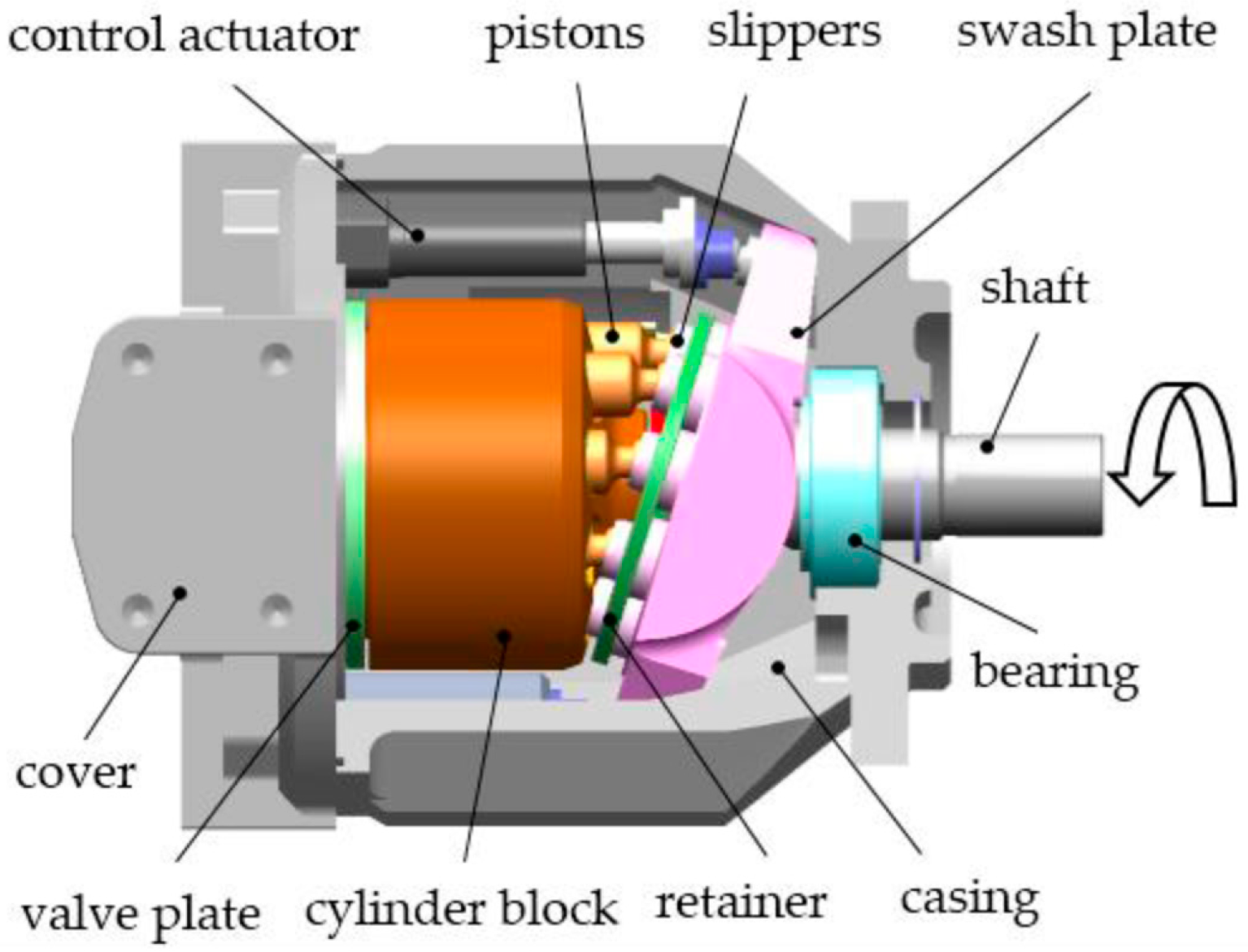
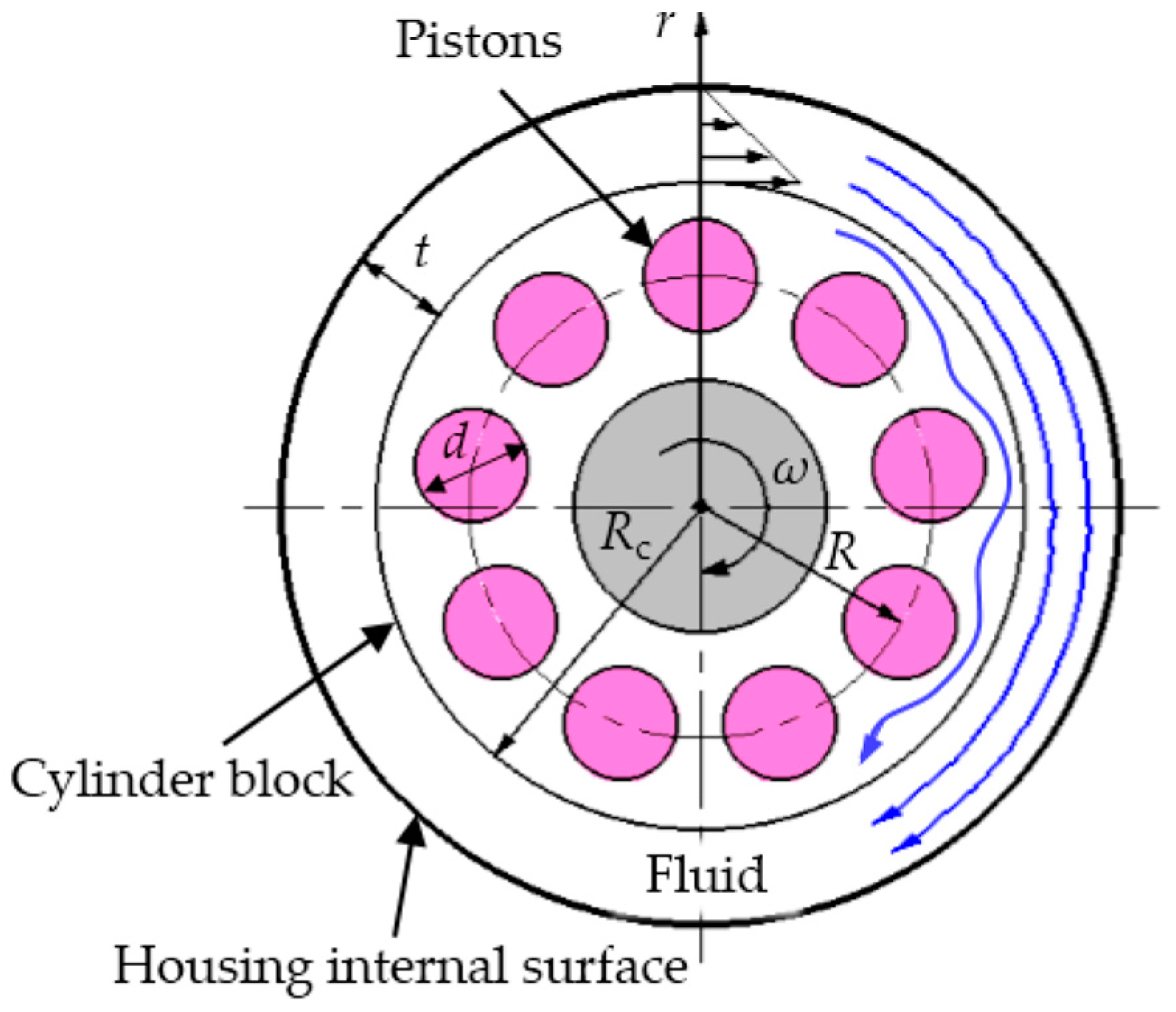

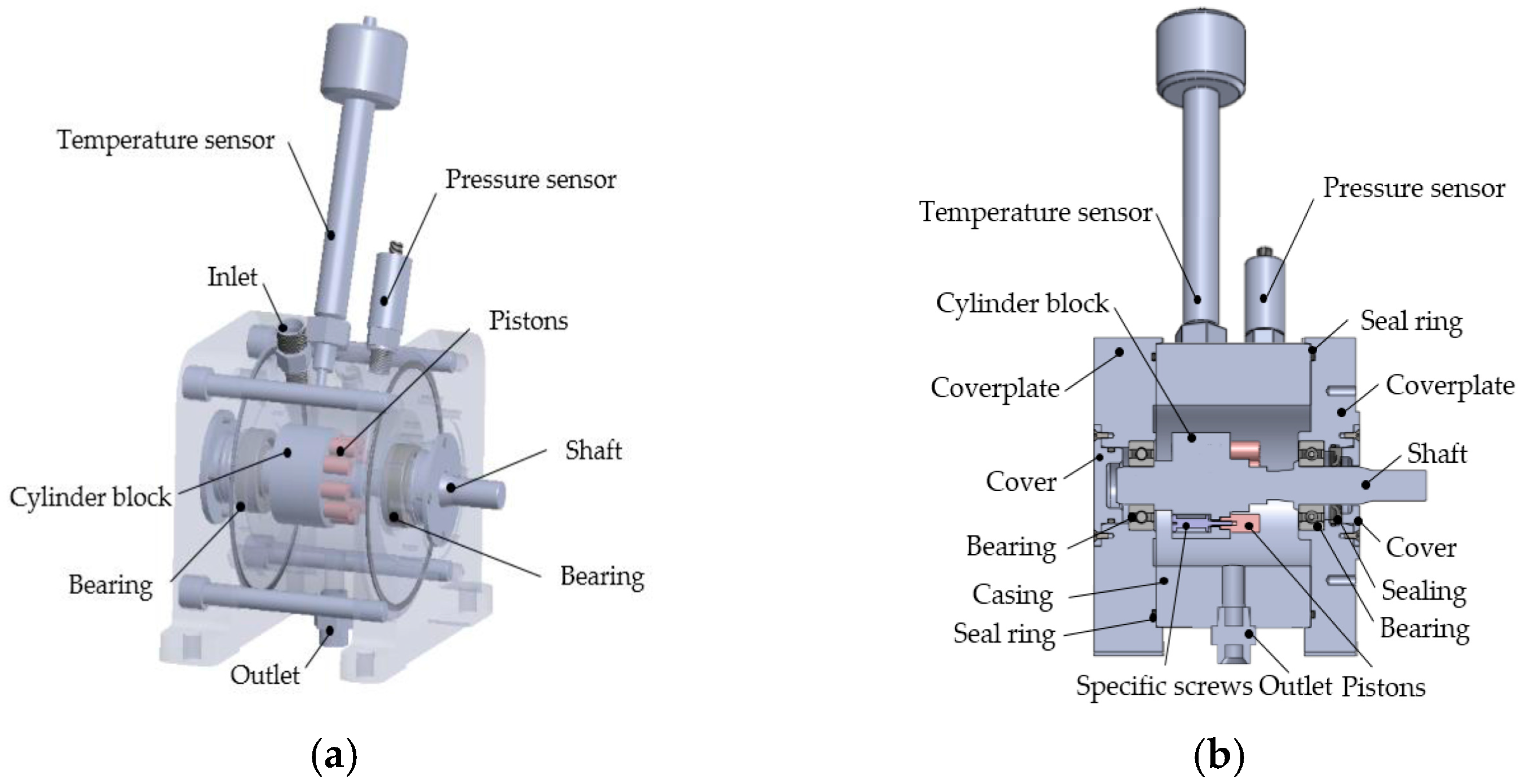
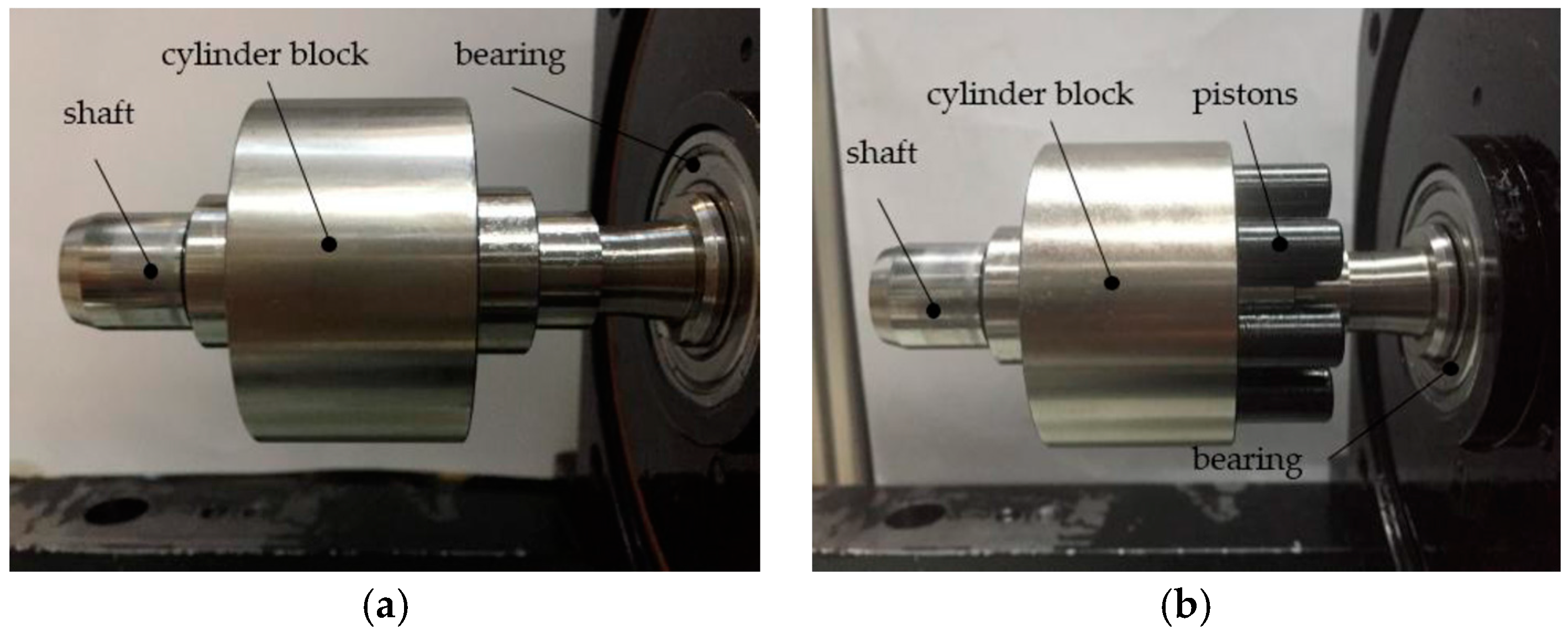



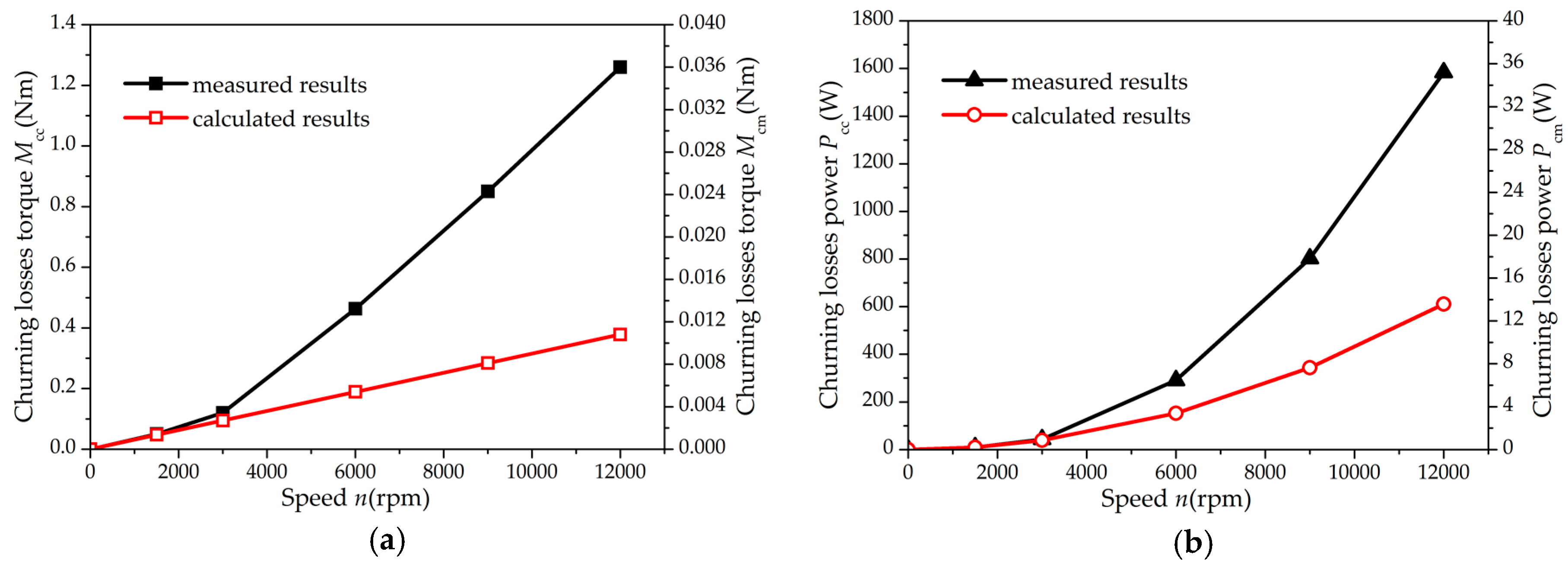
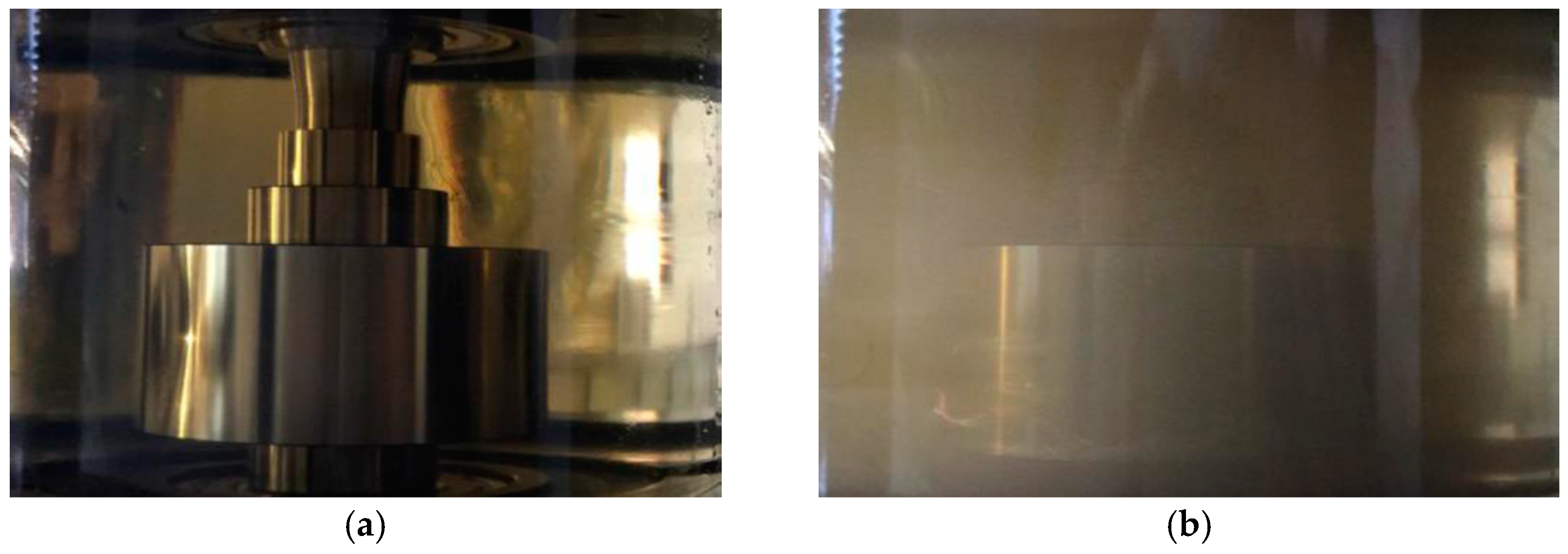
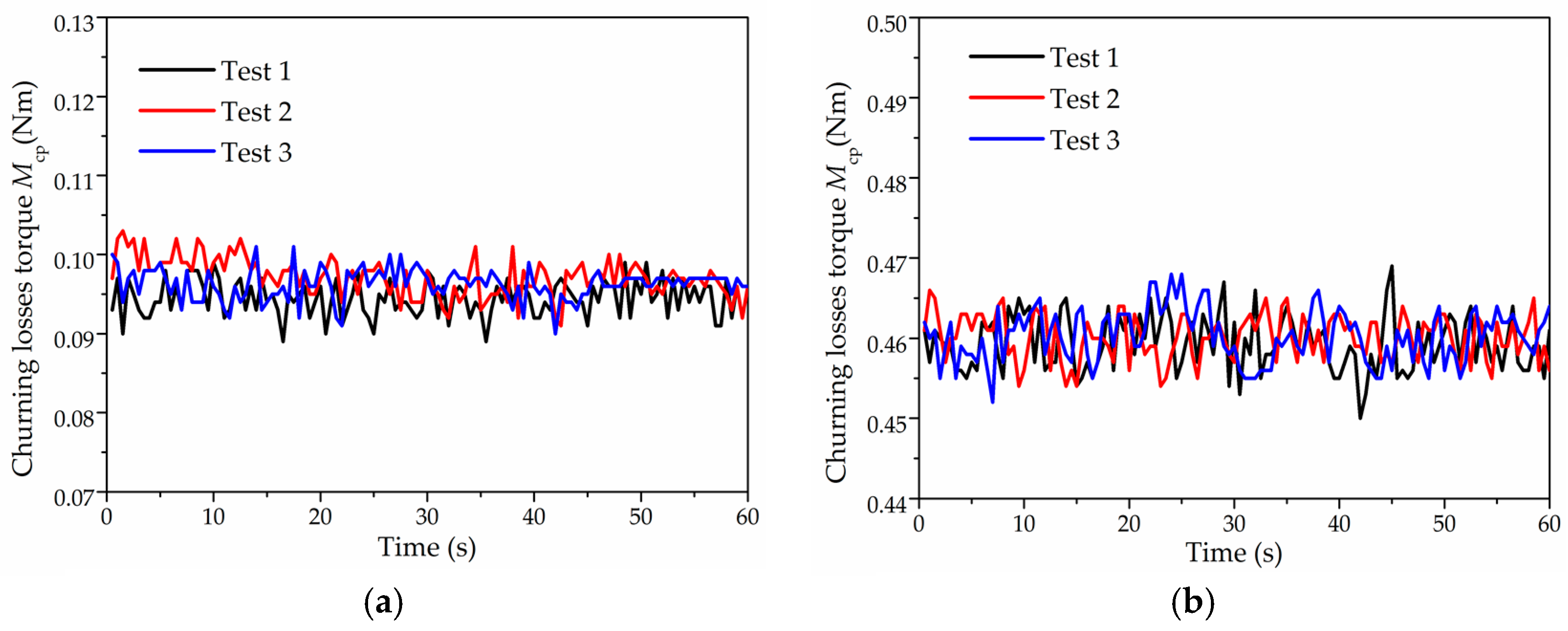
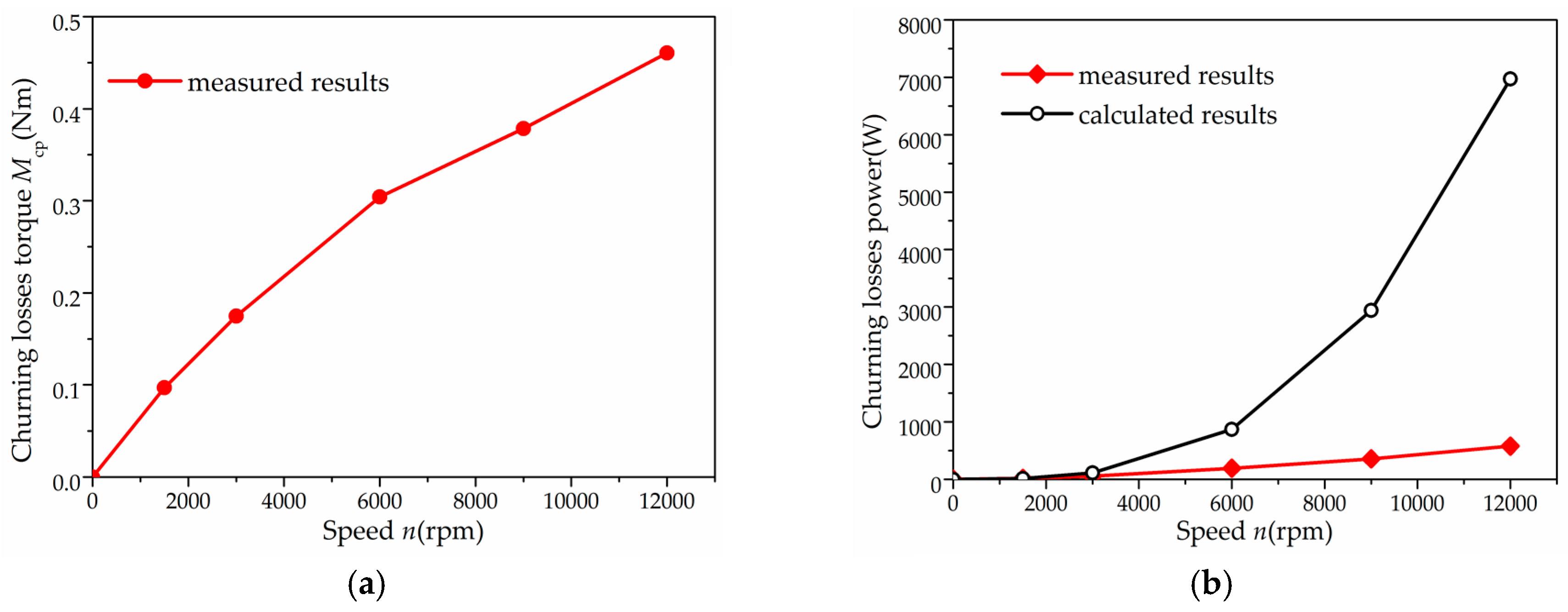

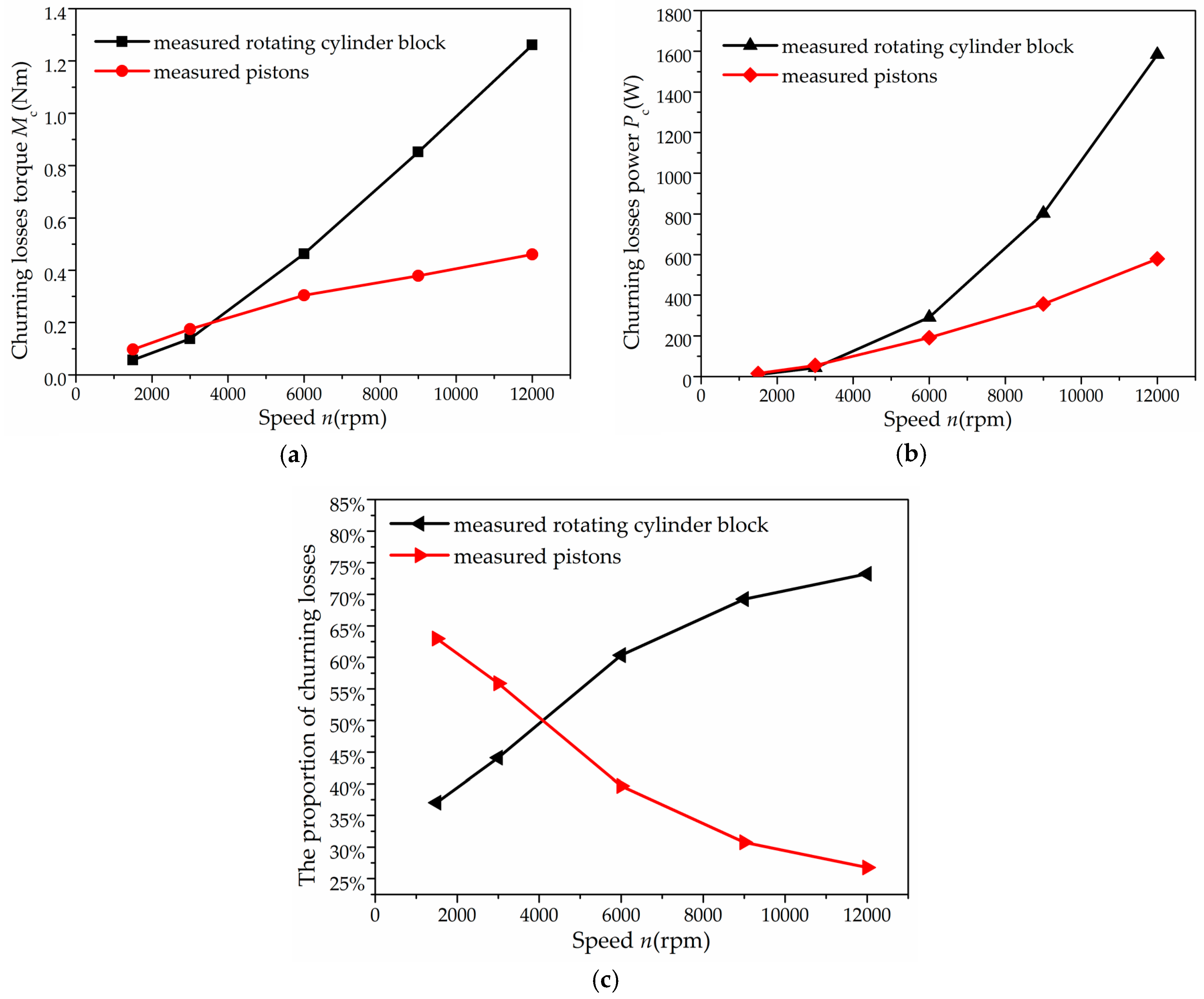
| Description | Detail |
|---|---|
| Torque-speed sensor | JN338, range 0–10 Nm, accuracy ±0.2%; range 0–16,000 rpm |
| Temperature sensor | NEXON, range −50–600 °C, accuracy ±0.2% |
| Pressure sensor | Huba, range 0–25 bar, accuracy ±0.3% |
| Parameters | Unit | Value | |
|---|---|---|---|
| The number of pistons | z | / | 9 |
| The diameter of the piston | d | m | 0.01 |
| The pitch circle radius of piston bores | R | m | 0.02 |
| The radius of the cylinder block | Rc | m | 0.028 |
| The length of the piston out of the cylinder block at the outer dead point | l0 | m | 0.0165 |
| The length of the cylinder block | lc | m | 0.0325 |
| The gap between the cylinder block and the housing internal surface | t | m | 0.0145 |
| Parameters | Unit | Value | |
|---|---|---|---|
| test speed | n | rpm | 1500/3000/6000/9000/12,000 |
| test temperature | T | °C | 35 |
| test pressure | p | bar | 1.02 |
| dynamic viscosity | μ | Pa·s | 0.0278 |
| density of test fluid | ρ | kg/m3 | 850 |
© 2017 by the authors. Licensee MDPI, Basel, Switzerland. This article is an open access article distributed under the terms and conditions of the Creative Commons Attribution (CC BY) license (http://creativecommons.org/licenses/by/4.0/).
Share and Cite
Zhang, J.; Li, Y.; Xu, B.; Pan, M.; Lv, F. Experimental Study on the Influence of the Rotating Cylinder Block and Pistons on Churning Losses in Axial Piston Pumps. Energies 2017, 10, 662. https://doi.org/10.3390/en10050662
Zhang J, Li Y, Xu B, Pan M, Lv F. Experimental Study on the Influence of the Rotating Cylinder Block and Pistons on Churning Losses in Axial Piston Pumps. Energies. 2017; 10(5):662. https://doi.org/10.3390/en10050662
Chicago/Turabian StyleZhang, Junhui, Ying Li, Bing Xu, Min Pan, and Fei Lv. 2017. "Experimental Study on the Influence of the Rotating Cylinder Block and Pistons on Churning Losses in Axial Piston Pumps" Energies 10, no. 5: 662. https://doi.org/10.3390/en10050662









